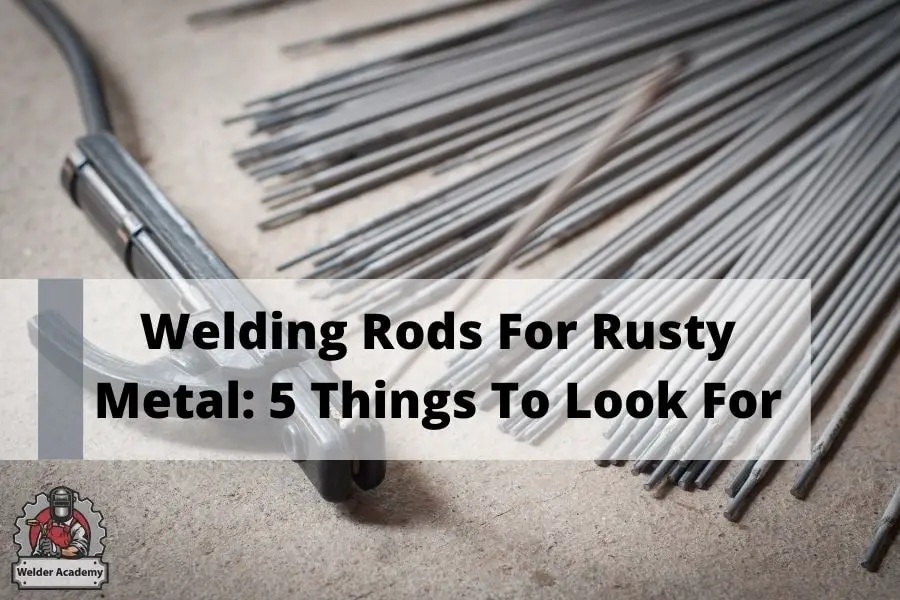
Before you start welding, you want to make sure the metal is clean and free of dust for ensuring a solid weld. Rust has a long-lasting effect on the welding quality, making the weld too fragile and the whole structure unable to withstand any heavy pressure.
When choosing the best welding rods, some of the more critical things to consider are the electricity type, welding strength, polarity, types of metal, welding rod size, the tensile strength of metal, etc.
This article will talk about five essential aspects of rusty metal welding that will help you. When speaking about welding rods for rusty metals, these 5 things are more important than you might think.
Effect of Rust on Welding
Any kind of contaminants like grease, oil, or rust can heavily impact the quality of the weld. Therefore, contaminants like rusts should be cleaned as much as possible before you proceed. Although, in some cases, it is very time-consuming and hard to remove all the rust entirely from the surface.
The main reason behind specialized welding is the adverse effect of rust during welding. When a metal surface is contaminated with too much rust, it makes the welding pool more solid, making it difficult to fuse the weld with the base metal.
As a result, welds resulting from this are significantly more prone to breakage and shattering. Moreover, the structure built with the weld will degrade and break down over time because of the added pressure.
Best Welding Method For Rusty Metal
Welding on a rusty metal is possible. However, it won’t be the most durable or the best-looking weld in any way because of the added contamination.
Welding on rusty metal comes with compromises, and you have to make peace with that. Although, with adequate knowledge and proper technique, you can create a functionally sound weld even on a contaminated piece of metal.
Here are the steps to follow:
Step 01: Assessment
The first thing you want to ensure is the type of metal bar you’re looking to weld and how bad the situation is – depending on the contamination.
Is the structure of the metal look sound? How about the rusting? Can the metal withstand the intended amount of pressure? These are the things you need to assess before you start welding.
Step 02: Choosing Welder Type
For rusty metals, the best decision is to use a stick welder, as this type of welder gives the best penetration along with hot enough temperature for creating solid, deep layers for added strength.
However, if you want to get more specialized work, using a MIG weld might also work depending on the metal and the structural durability you’re looking for.
Step 03: Surface Cleaning
Using a wire brush on the rusty metal vigorously will give you the cleanest result. It also helps in removing loose paints, dirt, and other contaminants. Using a hand grinder is also recommended. But no worries if you don’t have access to it.
This is important as any loose contaminant can ruin the weld and cause a weak bond. This is why proper preparation of the welding surface is essential.
Step 04: Setting Up the Weld
After cleaning up the rust as much as possible, you should position your weld in the proper place and set up the ground clamp along with it. Stick your metal with the clamp so that you can perform appropriate welding with the welding rod.
Step 05: First Layer of Welding
After you finish setting up the weld, the next step is to put the first layer or first pass of welding to the metal. Again, keep in mind the type of welding rod you’ve been using.
For smaller rods like ⅛” rods, you want to use .035 wire. As this particular welding takes longer than usual, I suggest that you turn down the amperage to prevent burning. If the weld gets too hot, it might burn through the metal.
Step 06: Check the First Layer of Welding
After doing the first pass, check to make sure the weld is strong enough and looks durable. Next, clean the weld with a wire brush to get rid of imperfections and dust. Check for the porosity and the level of penetration for determining the strength. Also, make sure the weld is not burnt or undercut the metal, as it will leave a weaker weld to work with in the future.
Step 07: Final Welding
If everything looks satisfactory after the assessment, you’re ready for the final welding.
You’d want to make sure the weld is strong enough and structurally as sound as you intended. Better to fix any mistakes before the final welding than to fix them after the final pass.
5 Things To Consider Before Choosing A Welding Rod
As there is no universal welding rod that works well on every type of weld, you need to choose the best kind of welding rod for your job. However, I’m here to make your life more accessible than ever, as I’ll discuss the factors you need to consider before choosing a good quality welding rod for rusty metal.
- Choosing Electrode
Choosing an electrode depends on a lot of things. Some of the most important ones are flexibility, corrosion resistance, coating material, welding position, polarity, etc. Make sure to consult the seller before making a decision.
- Type Of Electricity
As AC supply is readily available to work and they come at a lower cost, there’s a high probability that you’re working with it.
Using AC currents comes with some more considerations like the polarity of the electricity and specific type of welding rods. The most recommended welding rod for AC is the 6011 electrodes, as they are capable enough of cutting through a rugged coat of rust and dirt.
- Tensile Strength Of Metals
Tensile strength is another important consideration for choosing a good quality welding rod. You have to make sure the tensile strength of the electrode matches the tensile strength of the base metal as it will help withstand extra pressure.
Welding with a lower tensile strength rod in the future will cause structural deformity and fragility to the whole construction.
- Size Of Welding Rod
The size and thickness of the rod should be the same as the thickness of the metal you’re working with.
There are multiple charts available online to match your intended size with the welding rod. Before buying the rod, make sure it is of the recommended size of the metal bar.
- Types Of Metal For Welding
As different metals need different welding rods, you need the proper rod for the specific metal. For example, cast irons work best with ENiFe-C1 rods, while aluminum is compatible with E4043 rods. Moreover, the best rod for stainless steel is the E309L-16.
Different metals come with varying types of welding rod requirements for the best welding. So, make sure you’re using the proper one for the best result.
Final Words
Rusty metals are not recommended for a good quality weld. They provide significantly less durability, and they aren’t very long-lasting. But if you have to work with rusty metals, some techniques like using proper welding rods, amperage, and temperature help get the best results.
When choosing welding rods for rusty metals, 5 things to look out for are the size, tensile strength, type of metal, electricity, and electrode. After going through this article, you can hopefully make a more intelligent purchase decision according to the suggestions. Thanks for reading and until next time, farewell.
